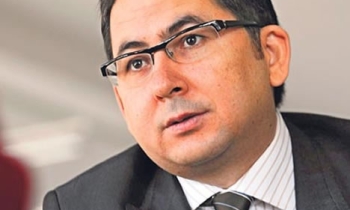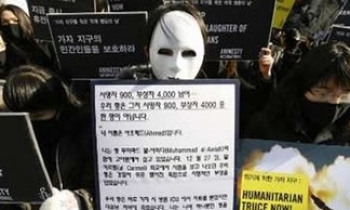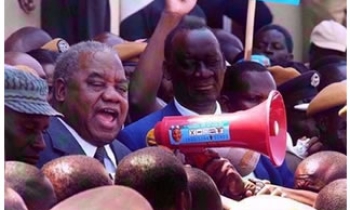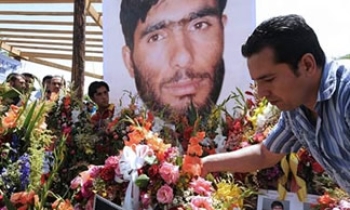When a press freedom violation takes place in Pakistan, the government reacts by stating, “The press is free in the country.”
This country, with a population of 150 million Muslims is, most of the time, ruled by a powerful US-backed military establishment.
A similar statement was issued again last month when the dead body of a missing tribal journalist was found in a tribal region after his “kidnapping” some six months ago.
Hayatullah Khan, a brave 29-year-old tribal journalist, was found dead on June 16 in the Khaisore Mountains near his hometown, Mir Ali, in the North Waziristan tribal district. The district has been scene to bloody clashes between local militants, known as Taliban, and Pakistani security forces, and it lies in Pakistan’s northwest near the Afghan border.
“My brother has honored his words that he would not compromise on freedom of press and freedom of expression,” Ehsanullah Khan, the 20-year-old young brother of the slain journalist, said after his body was brought home.
The young journalist, father of four, was kidnapped four days after he contradicted a federal government’s claim that the death of Abu Hamza Rabia, a leading Arab militant of al-Qa’ida, and four other people on December 1 last year was the result of an explosion inside the house.
On the basis of photographs he took at the scene for European Press Photo Agency (EPA), Khan said, “a US missile killed” Rabia. Villagers also endorsed his version saying a missile fired from a plane or a drone caused the explosion. An NBC TV report, citing anonymous officials, claimed a US drone launched the attack.
Three different inquiry committees ‑ one judicial, under the supervision of a high court judge, and two departmental – were set up to probe the murder of the journalist, who his family and most journalists in Pakistan suspect was killed by Pakistan’s “secret services,” a charge the federal government denies.
Our government moves swiftly when something serious happens and the establishment of a departmental inquiry or a judicial commission is ordered, but their findings never see the light of day.
Why was Khan killed? Was he killed because he tried to investigate an al-Qa’ida story as Daniel Pearl did? Or he was killed because leaving him alive would have invited serious trouble for those who kidnapped him? The three committees, hopefully, will find an answer to the questions people are asking.
Khan becomes the third tribal journalist to be killed for his profession in less than a year while covering the so-called war on terror in which innocent civilians are caught in the crossfire.
On February 7, 2005, two tribal journalists – Amir Nawab of APTN and Allah Noor of local TV channel Khyber – were shot dead in Wana, regional headquarters of another troubled spot, South Waziristan, where militants have taken over to rule the area with stricter Islamic laws, as the Taliban did in Afghanistan.
The situation of press freedom in tribal areas has taken a real battering with the killing of the two journalists in Wana, and today no journalist is living in South Waziristan because of the security threat; all senior journalists have migrated to “safer places” to escape threats to their lives.
Tribal areas are ruled through special Frontier Crimes Regulation laws, which human rights activists and liberal democrats call “draconian.” They are draconian because tribal people enjoy no rights unlike non-tribal people in the rest of the country.
No Pakistani court has jurisdiction over the tribal areas, thus denying the tribal people in general and tribal journalists in particular the right to information.
“There are no constitutional provisions to guarantee any fundamental human rights for the tribal people,” senior lawyer and former federal legislator, Latif Afridi, says.
Pakistan’s federal constitution guarantees press freedom but tribal areas are excluded.
“You have to make a choice between life and journalism. You cannot live with both in tribal areas,” says Sailab Mehsud of the Tribal Union of Journalists, explaining how difficult it is to pursue the profession in his areas, seen in the West as a “hotbed of al-Qa’ida and Taliban militants.”
Prior to Khan’s killing, cameraman Munir Sangi of the Sindhi language private TV channel Kawish Television Network (KTN), was shot dead in the southeastern province of Sindh on May 29. His killers are still at large.
The government produced two TV journalists before the court after they were detained illegally and secretly for more than three months for filming an air base which the US forces are using for logistic support to troops in Afghanistan.
Private TV channel Geo correspondent Mukesh Rupeta and assistant cameraman Sanjay Kumar were released on bail after the federal government indicted them for “divulging official secrets.”
The interesting part of the two journalists’ illegal detention is that while the two were employees of Geo TV, the channel did not report news of their disappearance until June 19. No reason has been given for the management’s silence.
Hundreds of press freedom violations, including the murder of journalists, physical attacks, threats from government and other pressure groups, and attacks on newspaper offices, have taken place but the state has not brought a single violator to justice so far.
It speaks volume for how vulnerable the media is in Pakistan despite the fact that the Pakistani media is resisting attempts to gauge it: Pakistan was in 150th position among 167 countries on the world press freedom index in 2005.
Khan’s murder has laid the foundation for press freedom in tribal areas. Khan is Pakistan’s Daniel Pearl, a brave American journalist who died while investigating an al-Qa’ida story in Pakistan’s Karachi city.









